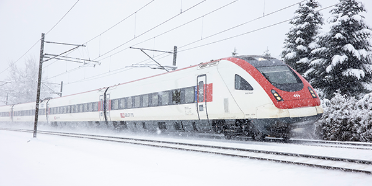- News
BFH and SBB develop onboard monitoring system for tilting trains
16.01.2023 The demands on the infrastructure are particularly high for the safe operation of high-speed tilting trains. In future, the infrastructure will be monitored during normal operations by means of a simple onboard system developed by researchers at BFH in collaboration with SBB. The system replaces expensive, elaborate measurement runs.
For safe and reliable rail operations, it is important to perform regular measurements of the vehicle dynamics (wheel-rail forces), especially for high-speed tilting trains. By taking bends faster than normal trains, they put more strain on the infrastructure. As things stand, the wheel-rail forces are determined once a year during inspection runs. In these measurement procedures, which are prescribed by specific regulations, the wheel-rail forces are determined using what are termed ‘measuring wheelsets’, a proven measurement system that provides reliably reproducible data. However, their numerous components make them a complex and correspondingly vulnerable system that requires a relatively high level of maintenance as well as needing to be laboriously calibrated from time to time. In order to obtain more regular and cost-effective information, researchers from the Institute for Intelligent Industrial Systems I3S at Bern University of Applied Sciences BFH, working with SBB, have developed a simple onboard monitoring system that can be used reliably and cost-effectively in regular operations.
Accurate predictions thanks to machine learning
Instead of deploying measuring wheelsets, the newly developed monitoring system uses only low-maintenance measuring technology, such as acceleration or displacement sensors. This simple sensor technology is easy to replace and withstands the harsh conditions trains are exposed to in daily operations. This gives the system higher cost-efficiency and availability than the conventional monitoring process. Based on the measurement data collected during each journey, the system predicts the forces that are relevant for evaluating the cornering safety of tilting trains. The vertical forces are predicted by measuring the wheel suspension travel. This prediction method is already proven for the testing of rail vehicles. However, until now there has never been a reliable method for predicting the lateral forces on the guide wheel and the entire wheelset – which was why this was the focus of the project. The researchers developed a new approach that, thanks to machine learning, can predict the lateral forces on the wheels based on the lateral acceleration. Beyond the linear relationship of mass, acceleration and force, the system can thus also deal with non-linearities of the moving train as a mass-spring-damper system. As a result, the new system can replace the cost-intensive measurement runs by facilitating the continuous checking of the rail.
Inspecting high-speed cornering in commercial operations
This new Onboard Monitoring System (OBM), which uses what is referred to as ‘simple sensor technology’ for calculating the safety-relevant wheel-rail forces, must be specified for each type of tilting-train, appraised by a recognised expert and finally approved by the supervisory authority. After that, one train per fleet is to be equipped and operated with OBM with this ‘simple sensor technology’. This OBM train will measure and record vehicle responses on a daily basis in commercial operations. The measurement data is then sent to a central computer and processed off-board in an automated data management system. Compliance with the regulatory limits is verified as part of the automated railway infrastructure monitoring, so that track maintenance measures can also be triggered, as necessary.
